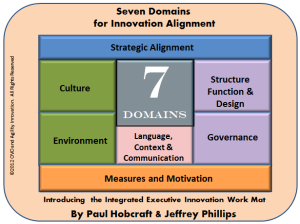There is always a healthy debate on who has ownership of innovation within any organization. Often it can boil down to where the innovation concept is along the pipeline or who has been designated with manoeuvring or piloting the innovation through its different stages.
The reality of lasting ownership is much tougher; there are huge, often yawning gaps, in innovation accountability. The right answer should of course be everyone but making that statement on its own is a little bit of a cop-out, an easy answer to a complicated dilemma. So let me offer a connected way.
Working through the Executive Work Mat , jointly developed with our friends at Ovo Innovation, this Work Mat was designed for many reasons but principally to gain leadership engagement within all things involving innovation.
One of its overarching principles was the quest to gain alignment from the top, at the board level, through its interconnected structure and their strategic inputs so as to establish and make the critical connections all the way down and throughout the organization.
What we needed also was putting in place a fairly rigorous ‘litmus test‘ to establish if this is achieving the positive reaction required and the Work Mats intent.
Continue reading “Taking ownership for innovation – the litmus test.”
